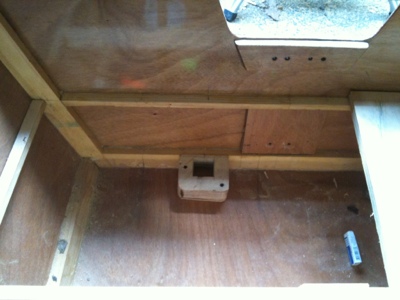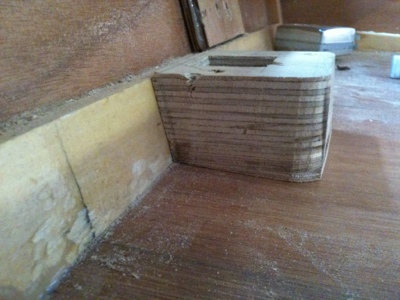I decided early on that for the long haul to Vermont I would flip the boat over, allowing the hull bottom to act as a more aerodynamic shape. This meant fitting the bunks to match the boat's gunwales.
The designer has recommended that the hull should be supported as near the bulkheads as possible. This is the strongest part of the hull and should prevent any problem with perforating the relatively thin plywood skin of the hull.
With the distance between bunks sorted out, I placed them on the frame to determine where they could be bolted down. The trailer is longer than most this size, but I still had precious little room to work with. Placing the rear bunk at the very back end of frame meant the bow stem of the hull would not clear the winch post of the trailer. Good thing the post is bolted--not welded--to the frame.
After making some adjustments, I secured the bunks with galvanized hardware and added foam to protect my pride and joy. The keen observer will notice small blue markers indicating the bulkhead position. This helped the two manual laborers (me and my wife) place the hull in its correct position quickly.
That's when I noticed how close a fit there was at the bow's tip. There was maybe a half an inch (13mm) of clearance and I'm sure the whole system has more than a half an inch of play in it. The picture below shows a bit of foam padding, but I knew that would not be the solution.
Below is proof that the shims did the job. The first pic was taken at a highway rest stop after 40 miles of driving. The second is at the destination, 226 miles from the start (about 4 hours of driving).
Observations:
--The suspension did a great job of absorbing the rough stuff without bouncing like a ball. My brother tells a horror story of towing a Sunfish (close to the weight of the GIS) on a Trailex aluminum trailer (a very popular product) and seeing in his rearview mirror the boat getting airborne, throwing moves like a snowboarder. The Goat was far more mature.
--The overall weight is laughable and could easily be pulled by my compact 4-cylinder Ford Focus hatchback. I'm not sure that I ever do that now that I have The ManVan in the fleet. But you never know.
--I'm happy with the balance fore-and-aft. The hull's center of gravity is forward of the trailer's axle, but not excessively so that would place a great load on the hitch (i.e. tongue weight). Likewise, the hull doesn't extend too far back. I have seen photos of some GIS trailers that worry me (including one on the roof of a very small car).
--There is enough flex in the frame that the bunk shims were necessary. It is what it is, but my future plans will help remedy that.
Future plans:
--I wired the lighting to include a plug at the rear to accommodate a transom light bar. I have the additional lights and wiring, so if I weren't typing this post, I could be making the light bar. My idea is to have a clamp system that would fit through the tiller cutout. I'd like the clamp to rotate relative to the light bar to accommodate the different transom angles, upright versus inverted.
--Speaking of upright, I plan to notch the bunks between the current gunwale notches to secure the boat in an upright orientation. This will allow me to launch directly off the trailer which is the only way I'll be able to sail single handed (like many men, I'm allergic to asking for help).
--Although I was able to lash the mast to my van's roof and stuff the spars inside the cabin (just barely), that's not how I want to do it. I plan to make spar storage tubes that will tuck under the hull. I've looked into actual tubes, plastic drainage pipes, but the cost is not reasonable. Instead I will build 16-foot long boxes (or a single divided box) that will run the length of the trailer. I think they could add stiffness to the frame and will certainly raise the hull from the frame reducing the risk of hull-to-frame contact. The box-tubes will have holes for drainage and ventilation and to allow for flooding during ramp launches. They could also sprout other storage compartments for rigging, gear, etc.
--I wouldn't mind replacing the 8-inch wheels with 12-inch wheels, which are better suited to long distance hauls. It's not a high priority, but if these tire catch a flat I'll spend the extra for the upgrade.
--I also plan to show this trailer to the gentleman that built it. I think he'll be happy to know that a fellow wooden boat builder is putting it to good use.
Stay tuned for more Goat tales...






















